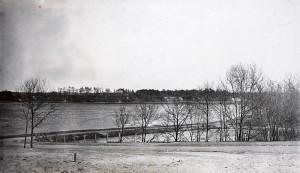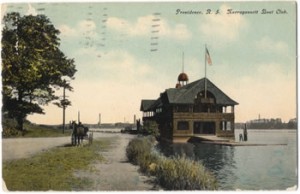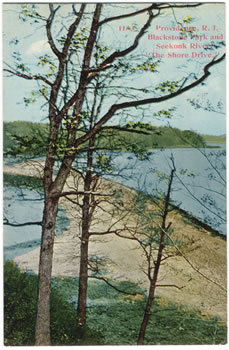 Picture Native Americans traveling from the East Side of Providence to East Providence. Their important route, the Wampanoag Trail, included a portion that went through Blackstone Park in the area of what is now called South Angell Street. Once they reached the end of land they forded the Seekonk River and continued their travels.
Picture Native Americans traveling from the East Side of Providence to East Providence. Their important route, the Wampanoag Trail, included a portion that went through Blackstone Park in the area of what is now called South Angell Street. Once they reached the end of land they forded the Seekonk River and continued their travels.
In 1866 Moses B. Jenkins and William P. Vaughn donated ‘for a public park’ five acres including a stream and the ravine between Butler Avenue and the Seekonk.
In the late 1860’s, developers mapped out the adjacent area south toward Angell Street with winding roads and house lots. Because it seemed a long distance from the developing city only a few houses were built and it remained relatively untouched until after the turn of the century.

A late nineteenth-century interest in including parks and green space in city plans led to the development of the area as a public park. Subsequent purchases enlarged the park to its present 45-acre size. However, for years the park was neglected. People removed sand from the banks to use for building. When the city planted pines to stop this activity, many of those were dug up to improve private yards.
In 1908 the city improved the park under the stewardship of Parks Superintendent Greene. Improvements included the creation of a bridle path for horseback riding and grading the bluffs fronting on Irving Avenue. The stairway was built to York Pond from the bluffs. River Road was improved (although not paved).
During the Great Depression in the 1930’s, the Works Progress Administration (WPA) built square stone pillars and wall at the edge of the woods opposite the Narragansett Boat Club. These were part of a planned entrance to the park from River Drive that was never completed. In addition, the WPA built the pillars and wall at the foot of the stairs near York Pond. The WPA also may have paved the road, and almost certainly added curbstones and sidewalks.
WPA plaques may be found in two places, one on the outflow structure of the pond, and the other on the right hand pillar opposite the Narragansett Boat Club.
The park borders the Seekonk River all the way from the Henderson Bridge to Gulf Road, where a stone wall divides it from Butler Hospital property. It is divided into three sections by Irving Avenue and Angell Street, which end at the river. There are trails throughout the wooded areas. The central area is the most open where some of the trails follow old wood roads. During the fishing season, people fish in the river. Boats from the Narragansett Boat Club are on the river from dawn to dusk, weather permitting.




